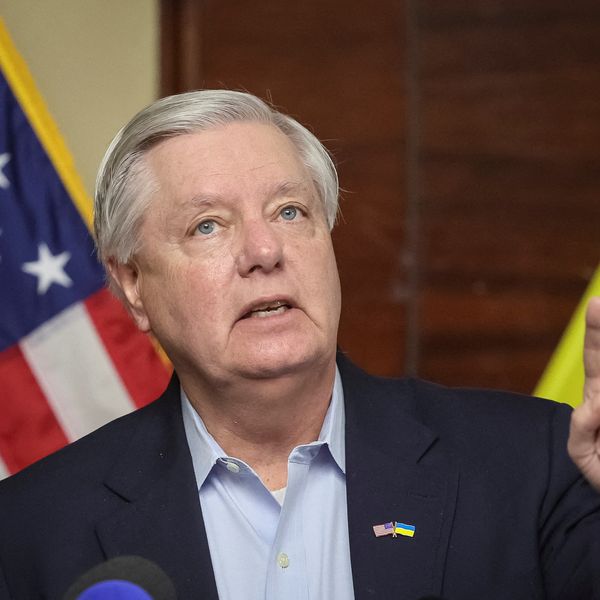Ties between Silicon Valley and the military industrial complex are not new. But the alliance of tech billionaires and venture capital titans working together to turn the Pentagon into a money spigot to fund far-future military gear is a novel conspiracy.
Their uniquely deranged rhetoric hits all the high notes: the revolutionizing power of unbridled capitalism, tech as a panacea for all social ills, the absolute necessity of U.S. military hegemony, and (as prime mover) our precarious position on the cusp of the Chinese century.
Like all conspiracies against decency, common sense, and restraint, this one has lots of speaker tours and expos. Here are some of the craziest things I remember hearing as I wandered around the recent Artificial Intelligence Expo for National Competitiveness in Washington, D.C., and my attempts at translation:
- “The Pentagon can now lend money directly to companies — that’s a great deal for American taxpayers.”
Translation: You thought the previous six audits we failed were bad, wait until we have a loan portfolio to manage. - “Pentagon contracting needs a fundamental redesign — we can’t just tweak it anymore.”
Translation: We’ve been slowly eating away at DOD’s annoying oversight and regulatory units over the last 50 years but if you could just finally get rid of those people we’d appreciate it. - “Microsoft is part of the industrial base — but if we are to bring the full enterprise suite into classified government work this will require massive amounts of investment capital.”
Translation: The best things in life are free but operating any of our products is going to be like so expensive. - “A decade ago Silicon Valley didn’t agree with the DOD mission — they’ve done a complete 180.”
Translation: Retaliating against all those tech worker sit-ins and union organizing was really effective. - “The [pro-Palestine] peace activists are war activists — we are the peace activists!”
Translation: I couldn’t translate this one because I blacked out and hit my head on the Palantir-sponsored mocktail bar. - “China isn’t this compartmentalized.”
Translation: Watch as American corporate executives discover the benefits of central planning! - “Edge computing is the future.”
Translation: If you want to have 800 military installations all over the world you’ll need a lot of distributed computing sites, we’d like to introduce you to our new product line: “forward operating servers.” - “In terms of AI-driven weapons accuracy, there’s too much superfluous data that isn’t necessary for targeting.”
Translation: At least this is what the Israelis are telling us. - “Too much data used for AI targeting comes from open source intelligence.”
Translation: Give us direct unhindered access to all your classified databases forever until we’re all dead. - “Are we close to having ‘Google-fired missiles’?”
Translation: Google executives’ search for ad revenue destroyed your primary product so have you considered pivoting from building browsers to blowing stuff up? - “Quantum computing can overcome the military’s GPS denial issue in Ukraine.”
Translation: If you buy our really expensive autonomous systems that can’t function without GPS right now we promise they’ll work in 5 years, or maybe 10 — okay definitely no more than 20 years. - “We need to eliminate dis-synergy.”
Translation: Creating meaningless corporate neologisms makes me sound innovative and disruptive. - “The Replicator drone initiative can put thousands of attritable systems in place in 18-24 months, but what they need is to break down barriers so they can do this over and over and over again.”
Translation: Save 10% on weaponized drones when you sign up for our subscribe and save option! - “Watch as I remote pilot this new drone that uses automated sensors to avoid obstacles. It can even run on a cell phone hotspot in the middle of Riyadh!”
Translation: This demo worked great when [please wait….system loading] I was in the middle of the desert [please wait….system loading] but apparently the high speed internet here at [please wait….system loading] the convention center in Washington DC [please wait…]. Oh well, never mind. - “Lockheed Martin is building an AI factory.”
Translation: Our excellent staff of quality control agents are literally strapped to their cubicles with their eyelids pinned open to issue recalls for any product that is definitely being built by an AI and not some guy in a robotic exoskeleton playing Operation! using a closed circuit TV. - “These partnerships aren’t just about building a defense industrial base, they’re about building an American industrial base.”
Translation: About half of the supply chain parts are coming from China but it will still feel very American because you’ll be paying for it. - “The venture capital sector enables DOD to leverage tens of billions of dollars of VC money, which generates more money to invest in defense tech.”
Translation: We, the super rich, are the only thing standing between you and Red Dawn. I’ll soon be rendering your fat to make human candles for my apocalypse bunker but for now let’s make some great memories. - “But, if VCs keep losing on defense tech when firms and investors washout, that leveraging I just mentioned won’t happen.”
Translation: Remember when we all soiled our collective pants and you bailed out our investment accounts in Silicon Valley Bank even though they technically weren’t FDIC insured? Yeah we’d like to scale that up to infinity. - “Government needs to focus on capitalizing underlying industries (semiconductors, biochem) because VC can’t do that — it takes too much capital and the timeline is too long.”
Translation: Can the taxpayer front the money for the really big expensive hardware stuff so VCs can just invest in the more short-term profitable stuff? I single-handedly employ an entire firm of asset managers to oversee my Belgian Malinois’s stock portfolio so if you don’t do this you’re destroying American jobs. - “VCs focus on the really hard things (quantum computing, advanced materials) because they only want the big wins.”
Translation: None of this stuff will ever perform the operations we’re talking about but that’s okay because we create enough hype around it and get in early enough that we can cash out before that becomes a problem — for us. It’s still a big problem for you because you listened to us and now you’re broke.
- Killer AI is a patriotic duty? Silicon Valley comes to Washington ›
- The Pentagon is flirting with the dark side of AI ›
- Silicon Valley USA: are these 'patriots' mere harbingers of doom? | Responsible Statecraft ›
- How the Pentagon built Silicon Valley | Responsible Statecraft ›
- Forget regs, AI CEOs got a need for speed to 'beat China' | Responsible Statecraft ›
- Tech bros go to Washington: Coders want in on the kill chain | Responsible Statecraft ›














